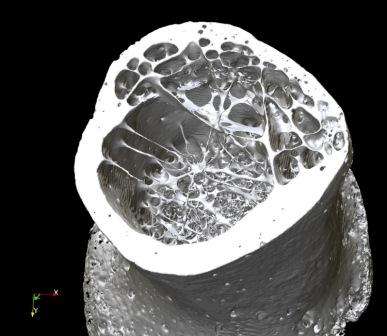On the path to better bone health

As Australia's population ages, degenerative bone diseases such as osteoporosis and osteoarthritis will take an increasing toll on the nation's healthcare system.
In a bid to prevent the burden of disease, researchers from Flinders University are using advanced microscopic techniques to better understand how and why bone loss occurs in the elderly.
Chief investigator Dr Egon Perilli said a special X-ray method known as a micro-computed tomography, or micro-CT, is enabling his team to analyse the complex structures of the skeletal system, including bone density and the thin internal features of the bone, in 3D.
He said the technique allows researchers to characterise the "microarchitecture" of the bone at a level which cannot be seen with conventional scanners in clinics.
"Conventionally, to see images at the same level, you have to take a biopsy, literally slice it up and look at it under a microscope but when you cut it up you destroy the 3D features," Dr Perilli, Senior Research Fellow based in the School of Computer Science, Engineering and Mathematics, said.
"On the other hand, micro-CT allows us to preserve the 3D structure of the bone biopsy because you don't need to cut it up to examine it," he said.
"The same bone can also undergo mechanical testing, and the data used in computer simulations, to investigate the relationships between bone density, microarchitecture and mechanical competence.
"With the previous method at the microscope, you'd need to take two separate samples to get that kind of information because the first one would have been destroyed by cutting it up."
By understanding how bone loss occurs in the elderly, Dr Perilli said he hoped to contribute to develop better diagnostic tools to identify patients at-risk of fractures while creating advances in the prevention and treatment of musculoskeletal diseases.
"Many patients currently identified as osteoporotic, and therefore at increased risk of fracture, might not actually experience a fracture later in life. Yet they fall into this risk category because of their low areal bone mineral density; and thus probably receive pharmaceutical treatment.
"However, there are also a number of people who instead don't fall into the osteoporotic category and are possibly not getting treatment when they should.
"So a key aim of this research is to find a way to better diagnose patients at risk.
"If we better understand why bone loss happens, and how to identify when a patient has lost a critical amount of bone that would put them at risk of fracture, we can look at developing more targeted therapies to reduce that risk and also delay, if not obviate, the need for hospitalisation or expensive surgery associated with fracture repair."














